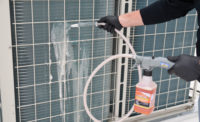Coils are sized to match the Btu cooling requirement of the home or building. Both condenser and evaporator coils are engineered to provide optimum heat transfer as required by the area being cooled. Optimum heat transfer and system efficiency is predicated on clean coil surfaces.
The air moving across these coils will, in most cases, contain a mixture of dust, dirt, pollen, grease, and moisture. Airborne contaminants settle on the coil surfaces, impacting the coil’s ability to transfer heat. Pollen, bacteria, and mold spores on the evaporator coil will not only reduce heat transfer, but will also affect the quality of the air within the home or building.
The cost of operating dirty air conditioning and refrigeration equipment is greater than you or your customer might suspect.
POWER COSTS
Dirty condenser coils increase power costs. When the coil becomes fouled with dirt and grime, it cannot provide adequate or designed heat transfer.The soil’s insulating effect causes higher discharge pressure. The higher discharge pressure increases amp draw and run time of the compressor, at the same time reducing capacity. Equipment operating with dirty coils may use as much as 37% more energy than equipment with clean coils.
Let’s take a look at a 10-ton air conditioning system with a typical kilowatt cost operating for an average cooling season of 1,500 hrs. It costs approximately $1,650 to operate this system with clean coils. However, when the condenser coil becomes dirty, the six-month cost of operation escalates 37% to $2,260. With rising energy costs, like those experienced in California, the cost of a dirty coil can be even greater.
From this example, just by keeping coils clean, $610 savings can be realized in one cooling season. That’s a savings of $61 per ton. A typical, 4-ton residential system would realize $248 savings in one cooling season. Areas with longer cooling seasons or higher-than-average power costs can realize even greater savings.
The cost of dirty coils goes even further. As dirt and grime collect on the condenser, they restrict heat transfer, causing the compressor to work harder; more heat is added to the system, thus causing the head pressure to rise. Rising head pressure will result in a loss of cooling capacity of up to 30%.
If our 10-ton system with a 30% loss now only provides 7 tons of cooling, the system not only will cost more to operate, it will provide less cooling. This loss of capacity will typically be most noticeable on the hottest days, when cooling is needed most.

LIFE EXPECTANCY, IAQ
Higher operating pressures and temperatures caused by a dirty coil may reduce the equipment’s life expectancy. The elevated system temperature and pressure may lead to the breakdown of the compressor’s lubricant. In addition, acid formation can occur, leading to an acid burnout. Lubricant breakdown and acid formation seriously compromise the compressor and ultimately lead to equipment failure.Compressor failure means no cooling, which means no comfort for the home or building occupants. And, compressor replacement means a considerable cost to the home or building owner.
The evaporator coil concerns go beyond the efficiency issues discussed thus far. A dirty evaporator coil creates an excellent breeding ground for bacteria and mold that can impact a building’s indoor air quality.
Cleaning, sanitizing, and protecting the evaporator coil, condensate pan, and surrounding areas is critical. Use the proper cleaners and treat with the proper EPA-registered products.

MAINTENANCE PROGRAM
Adopting a coil maintenance program will enhance your reputation and increase your revenues. Coil cleaning is one of the most profitable service procedures a contractor can offer.Coil cleaning and preventive maintenance enables the servicing contractor to offer customers the following benefits:
Many home and building owners welcome opportunities to practice conservation specifically in cases when they will realize savings without sacrificing comfort. Most of these equipment owners are unaware of the significant energy savings and comfort benefits of a regular coil cleaning and maintenance program.
If the service contractor can explain these benefits to customers, that contractor can add profitable revenues while helping his customers save money.
Leach is product manager with Nu-Calgon of St. Louis, MO. For information regarding the coil cleaning program, visit www.nucalgon.com (website) or call 800-554-5499.
Publication date: 07/02/2001




